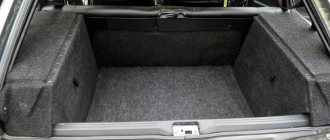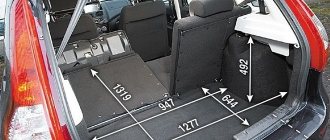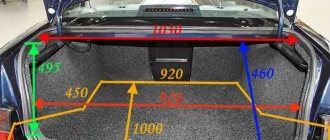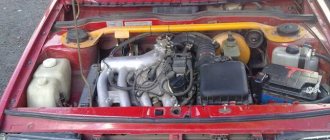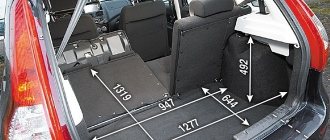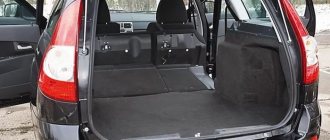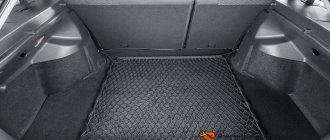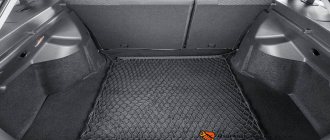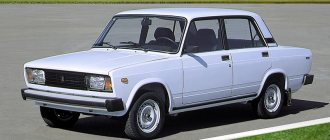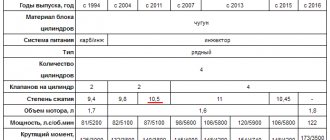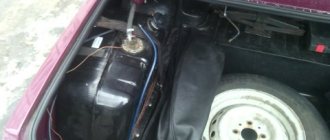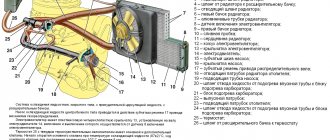Dimensions Lada 2109 restyling 1991, hatchback 5 doors, 1st generation
04.1991 — 08.2006
| Options | Dimensions | Weight, kg |
| 1.1MT 21091 | 4006 x 1650 x 1402 | 915 |
| 1.3MT 21090 | 4006 x 1650 x 1402 | 915 |
| 1.5i MT 21093-20 Standard | 4006 x 1650 x 1402 | 920 |
| 1.5i MT 21093-21 Normal | 4006 x 1650 x 1402 | 920 |
| 1.5i MT 21093-22 Lux | 4006 x 1650 x 1402 | 920 |
| 1.5 MT 21093-00 Standard | 4006 x 1650 x 1402 | 945 |
| 1.5i MT 21093-20 Standard | 4006 x 1650 x 1402 | 945 |
| 1.5i MT 21093-21 Normal | 4006 x 1650 x 1402 | 945 |
| 1.5i MT 21093-22 Lux | 4006 x 1650 x 1402 | 945 |
| 1.5 MT 21093-01 Norm | 4006 x 1650 x 1402 | 945 |
| 1.5 MT 21093-02 Lux | 4006 x 1650 x 1402 | 945 |
| 1.5 MT 21093-20 Standard | 4006 x 1650 x 1402 | 945 |
| 1.5 MT 21093-21 Norm | 4006 x 1650 x 1402 | 945 |
| 1.5 MT 21093-22 Lux | 4006 x 1650 x 1402 | 945 |
VAZ 2113
Thanks to the trunk volume of the VAZ 2113, drivers have the opportunity to transport large cargo. Its capacity is 330 liters. The technical characteristics of the luggage compartment make it possible to transport items of non-standard sizes.
The trunk of the 2113 model is transformable: the driver can remove the shelf and fold down the rear seats. After this, its capacity is 632 liters. The hatchback allows you to transport small and long cargo.
Disadvantages include the lack of standard lighting (when tuning a car, you install it yourself), a high loading side, which makes it difficult to place cargo inside.
Dimensions Lada 2109 1987, hatchback 5 doors, 1st generation
03.1987 — 08.1993
| 1.1MT 21091 | 4006 x 1650 x 1402 | 915 |
| 1.3MT 21090 | 4006 x 1650 x 1402 | 915 |
| 1.5 MT 21093-00 Standard | 4006 x 1650 x 1402 | 945 |
| 1.5 MT 21093-01 Norm | 4006 x 1650 x 1402 | 945 |
| 1.5 MT 21093-02 Lux | 4006 x 1650 x 1402 | 945 |
| 1.5 MT 21093-20 Standard | 4006 x 1650 x 1402 | 945 |
| 1.5 MT 21093-21 Norm | 4006 x 1650 x 1402 | 945 |
| 1.5 MT 21093-22 Lux | 4006 x 1650 x 1402 | 945 |
Basic reference dimensions for checking the body floor
| baselines | |
| 1 | axis of the front bolts securing the front suspension braces |
| 2 | support center of the front suspension of the power unit |
| 3 | center support of the left suspension of the power unit |
| 4 | centers of the upper hinges of the front telescopic struts of the front suspension |
| 5 | front suspension arm hinge centers |
| 6 | points of intersection of the axes of the welded bolts securing the steering mechanism with the surfaces of the brackets |
| 7 | mounting points for the rear suspension mount of the power unit |
| 8 | points of intersection of the axes of the rear welded bolts securing the rear suspension arms with the surfaces of the rear side members |
| 9 | centers of the upper shock absorber mounts of the rear suspension |
Testing for deformation can be carried out using the following methods, succinctly called “old-fashioned”. They will help you get at least a rough idea of the condition of the metal frame of the VAZ 2108:
Open and lightly slam all the V8 doors and the hood one by one. Don’t try to make every effort, act carefully. In case of insufficient, loose closing of the doors the first time, there is a curvature of the pillars. If the hood does not close tightly, it is recommended to check the side members for bending.
- Another inspection option involves a visual inspection of the side of the car. This way it will be possible to detect existing irregularities and increased gaps;
- Glass should also be subjected to visual inspection. If cracks are noticeable on them, especially vertical ones on one side, there is a curvature of the racks;
- Compliance is also checked while the vehicle is moving. So, the G8 driver is recommended to increase the gas on a good, flat road to 50 km/h, and then lower the steering wheel for a split second. If the car pulls in any direction, there is a displacement on that side. The same experiment should be carried out at a speed of 90 km/h.
An interesting video review on the topic of proper equipment for body restoration.
”
Technical characteristics of the VAZ 2109 “Nine”
VAZ-2109 “Sputnik”/Samara (informal name “Nine”) is a Soviet and Russian front-wheel drive car of group II small class with a hatchback body. Developed and mass-produced at the Volzhsky Automobile Plant in 1987-2004. From 2004 to the end of 2011, the VAZ-21093 version was assembled from vehicle kits in Ukraine. It is a five-door modification of the VAZ-2108 in the Lada Sputnik family of models.
"Nine" "VAZ 2109"
1. Performance characteristics of the VAZ 2109 nine
Maximum speed: 160 km/h Acceleration time to 100 km/h: 13 sec Fuel consumption per 100 km in the city: 10 l Fuel consumption per 100 km on the highway: 5.7 l Fuel consumption per 100 km in the combined cycle: 7.3 l Fuel tank volume: 43 l Vehicle curb weight: 945 kg Permissible gross weight: 1370 kg Tire size: 165/70 SR13
2. Engine characteristics
Location: front, transverse Engine capacity: 1500 cm3 Engine power: 78 hp Number of revolutions: 5400 Torque: 115/3000 N*m Power system: Distributed injection Turbocharging: no Gas distribution mechanism: OHC Cylinder arrangement: In-line Number of cylinders: 4 Cylinder diameter: 82 mm Piston stroke: 71 mm Compression ratio: 9.9 Number of valves per cylinder: 2 Recommended fuel: AI-95
3. Brake system
Front brakes: Disc Rear brakes: Drum
4. Steering
Steering Type: Rack and Pinion Power Steering: No
5. Transmission
Drive: Front Number of gears: manual gearbox - 5 Gear ratio of the main pair: 3.9
6. Suspension
Front suspension: Shock absorber Rear suspension: Coil spring
7. Body
Body type: hatchback Number of doors: 5 Number of seats: 5 Vehicle length: 4006 mm Vehicle width: 1650 mm Vehicle height: 1402 mm Wheelbase: 2460 mm Front track: 1400 mm Rear track: 1370 mm Ground clearance (clearance): 160 mm Maximum trunk volume: 1000 l Minimum trunk volume: 270 l
8. Production
Year of manufacture: from 1987 to 2006
#7 Trunk of VAZ 2109 — logbook of Lada 2109 16v 2003 on DRIVE2
Hello everyone, here we will describe the pitfalls when remodeling the trunk, if you do it right away wisely and slowly, then you may not have to buy a second sheet of plywood as was the case in my case!) So for the floor, I recommend using a 12 mm plywood sheet. But I wanted to save money and first bought 8 mm, in principle this is normal, but since there are fastenings inside the trunk behind the headlights parallel to each other, which are responsible for the hook (for which you will drag some kind of bucket when it breaks)))) then I have The plywood bent due to the fact that we cut out the roof (for the spare wheel) without leaving a side, but we will fix this problem; there will be a photo of the floor later. The whole thing will be sealed with carpet (black) so far we have used a sheet of plywood 1525x1525 8mm. 380 rubles We bought x5 corners for 6 rubles, small self-tapping screws for 50 kopecks. per piece x60 and hinges on which the lid will rise and the side niche will open. There will be two niches + a spare wheel.
I'll probably post the dimensions later because... They grabbed quite a few hemorrhoids and a lot of things were corrected so as not to spend money on plywood... Yesterday we bought another 1 sheet of plywood only 12mm 1525x1525 560 rubles from which we make side inserts. The ovals will cut into these same side inserts. To be continued late in the evening, we plan to finish today!)
Smooth roads everyone)
That's how much space there is in the niche for trash)))
A door will be cut out from the side
Almost everything is ready, here's a photo, we're waiting for summer weather, it's been raining all day today! I'll describe everything later
The trunk will be redone, keep an eye on the bulletin board
VAZ 2109 body: introduction
Inside, the car body practically does not cause any complaints from car owners, despite its small, compact dimensions. However, there is enough space for a trip of five people of average build. The low-mounted dashboard is quite easy to operate; if necessary, you can build in modern electronic components, but this will require you to spend a significant amount of money.
VAZ 2109 body dimensions
There is a slight drawback in terms of the material construction of the interior, which is made of plastic. This is a significant drawback, since such a building periodically rattles and needs technical modernization to strengthen it. However, this is quite easy to do and you don’t have to spend a lot of money.
Major body repair
Major body repairs involve complete disassembly of the car. It is necessary to remove everything from the car, from the power plant to the interior trim, and drill out the resistance welding areas. This will allow you to detect hidden defects and carry out repair work most efficiently and less expensively.
When disassembling, take the “VAZ 21099 Operating Manual” as a basis. Damage can be varied, but the most common complaints are:
- the bottom, especially the left side, the driver’s seat, is often subject to particularly intense corrosion in Togliatti-assembled cars;
- trunk niches;
- rear side members;
- thresholds and threshold amplifiers;
- wheel arches (due to the design features, pay close attention to the rear ones).
If the rust is deep, there are cracks in the structure, and parts are subject to corrosion, including through corrosion, and deep deformation, then a major body repair will not be possible without welding work. It is necessary to weld problem areas. In most cases, parts need to be replaced. To do this, you can use a grinder to cut off areas and structural elements that are susceptible to through corrosion. In some cases, you have to buy a new bottom or limit yourself to a trough without a tunnel, it’s cheaper.
It is advisable to restore the geometry of the body after complete disassembly of the VAZ 21099, but in the conditions of an ordinary garage, it is impossible to do this with your own hands without special equipment.
After completing the dismantling and welding work, critical areas must be thoroughly treated with an anti-corrosion compound and painting can begin.
Control dimensions of the VAZ 2109 body
VAZ 2109 control body dimensions
The body has a rather short length - 4006 mm, which is an obvious advantage of the car, since compactness is important in urban environments. If we compare the manufacturer’s previous models, the body length of the VAZ 21099 was reduced by 120 mm, while there was 60 mm more space inside thanks to rational and correct design solutions.
The first production VAZ 2109 cars had a body width of 1650 mm, however, after a few months, the developers managed to reduce it by 30 mm to 1620 mm, this further increased the compactness of the body.
Body dimensions of VAZ 2109 and VAZ 2108
The body height is approximately 1402, which is 30 mm comparatively less than the body of its predecessor models. But the designers were able to compensate for the free space by creating car windows in a convex shape. On the one hand, this made it possible to increase the amount of free space, on the other, it made the vehicle more presentable.
The luggage compartment of the VAZ 2109 deserves special attention, which at one time made a real splash on the passenger car market. Even today, this almost revolutionary design feature has not lost its practical relevance.
VAZ 2109 body sizes
The standard trunk capacity of the Nine is 330 liters, but if necessary, it can be expanded to 640 liters by folding the rear seats. All this can be done in a couple of minutes and does not require much effort.
The front wheel track is 1400 mm, and the rear wheel track is 1370 mm. The compact dimensions of the VAZ 2109 body make it possible to efficiently transport small-sized cargo around the city, even during rush hour when there are a lot of traffic jams.
Control body size VAZ 21099
Note. The compact dimensions of the “nine” create opportunities for overtaking, since large passenger cars are practically unable to maneuver in traffic jams due to the lack of sufficient free space.
Read more about the technical characteristics of the trunk
The first models had a body width of 1650 mm, but after a while the developers reduced it by 30 mm. Thus, the compactness of the trunk has increased. Other options are:
- height – 1402 mm, which is 30 mm less than its predecessors. Compensate for the space of convex glass. This allows you not only to increase volume, but also to improve presentability;
- the capacity is 330 liters, and with the seats folded down – 640 liters.
At one time, the luggage compartment of the VAZ-2109 made a real splash on the market. Even today it deserves attention. Thanks to the compact dimensions of the body, it can transport small-sized cargo even when there are heavy traffic jams on the roads.
Note that the fuel consumption of this model is much less than that of an SUV. This increases the practical profitability of the VAZ-2109. Among the shortcomings of the body, it is worth highlighting only the following:
- rapid loosening of fastenings, which subsequently can weakly hold the load;
- periodic squeaking while the car is moving.
However, these problems can be easily resolved by contacting technical service. The cost of any repair work on a VAZ-2109 is quite affordable for all car owners. Despite some shortcomings of the body, it is still considered very reliable and practical. It can easily transport things purchased in bulk, or products, but in small quantities. Of course, you can’t fit a baby crib or stroller in there, but other things will fit comfortably.
If the squeaking really annoys you, you always have the opportunity to replace a separate functional element at a service station. In general, the spaciousness of the body and its convenient dimensions significantly affect the popularity and demand for the VAZ-2109. This machine is still actively used today due to its good appearance and decent technical characteristics.
The process of installing a lock on a VAZ 2109
This is where the fun begins - either I’m lucky, or others have had less luck, but it turned out that the lock from Kalina fits perfectly onto the bracket, which is already screwed to the boat under the rear wiper motor. True, I had to bend the petals a little and drill holes (from the trunk side). I found a photo of Kalina's castle and showed the excess parts with a dotted line - cut them off using a grinder or a hacksaw.
I immediately felt the disadvantage of this bracket - the connection is a little flimsy, so the lock can move and, as a result, the trunk of the Nine will not close. To make the connection stronger, you need a major corner. During my search, I came across a plate with perforation. I made a corner out of it and cut a hole for the lock lever (which opens the trunk). In the photo you can see this corner. You install it on the lyada and attach a lock to it. The rigidity is sufficient, so the door will not open while moving.
However, even if you use the first bracket, the likelihood of opening the trunk is extremely low. And now about the answer. In the photo you can see that it is screwed with the same bolts as the original one, into the same holes. One thing - I had to lift it slightly, for this I used two washers installed under the nuts of the cylinder head cover of the classic. They form beautifully, have a large support area, and the loop ultimately does not move to the sides.
To implement the electric drive for opening the Kalina lock on the VAZ 2109, a gearmotor with two wires was chosen. There is no point in taking five - there is no need for a limit switch. Check how the drive works - the rod is in the middle position, when connected to power (minus to blue, plus to green) it is retracted, when the polarity is reversed it is pulled out. Therefore, dance according to these parameters; for me it turned out to be more convenient to use the retraction mode, since it seems to me the most suitable.
Either now everyone has started actively repairing their cars, and at the same time their houses, but I couldn’t find a wire with a cross-section of about 0.75 square meters. mm. Well, maximum one and a half! Not anywhere, there is a yellow-green one (for grounding), and even that one is 2.5 square meters. mm. Therefore, the choice fell on a two-core one, the cross-section of each core is 0.5 square meters. mm. The Chinese usually use these in their household tape recorders. I screwed the gear motor to the bar and installed it on the trunk door. I screwed it onto the lock lever; to be honest, I don’t know what to call it correctly. Let this be an adapter that connects the lock rods and the drive spoke. This will probably be correct, but if not, then correct me. In the photo they are on the left in a bag.
These are the holes that appeared after I removed all the “unnecessary”
And now all that’s left to do is to connect the wires in the following sequence: cigarette lighter – button – motor output (green). The blue one, as you understand, needs to be screwed to the ground, fortunately there are plenty of bolts and nuts there. And the funny thing is that I removed the wiper and I already have at least three wires down to the steering column switches! I call and the choice falls on white with a blue stripe, and I use it as a feeder. And the purchased wire will be useful for something else. That's all, you try, evaluate, if necessary, loosen the fastening and move the lock body in the desired direction. And now one small “bonus”. There is a limit switch on Kalina's trunk lock, and I plan to use it to turn on the trunk lighting. I think the blue LED strip will be just right.
And to do everything as expected, you will have to use this circuit with a relay. The likelihood of damage to the button is reduced to zero. And the time has come to sum up and count the costs:
- Castle Kalina sedan - 450 rubles.
- The response part is 135 rubles.
- Electric drive - 170 rub.
- Button - 60 rub.
- Wire - 50 rub.
- Plank - 33 rub.
- Total - 898 rubles.
Engine weight and other characteristics
The lightest is the latest engine model 11183-20 - it weighs 112 kilograms. The remaining modifications are heavier (almost 128 kilograms). Interestingly, the lightest modification in weight is the most powerful - it has 81 horsepower. The first power plants were much more modest in parameters - the 2108 had only 64 hp. s., and 21083 has 69 “horses”.
What the power units have in common is the number of cylinders - all are equipped with four. Moreover, the first modification has a cylinder diameter of 76 millimeters, and subsequent modifications have a cylinder diameter of 82 mm. By volume, the engines have the following parameters:
- 2108 – 1.3 liters;
- 21083 – 1,5;
- 2111 – 1,6.
Engine 21081 was similar in basic parameters to the base one, but had low power - only 54 horsepower. An intermediate option, before the start of production of cars with a power plant from Kalina, was the injection 2111-80. The number of “horses” in it increased to 72, and the maximum speed reached 160 km/h.
